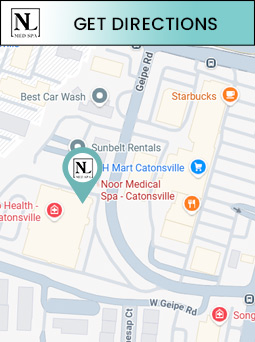What Is BMI, and How Is It Calculated?
Body Mass Index (BMI) is an easy equation that determines body fat percentage based on height and weight. It is a standard method for determining if a person is underweight, healthy weight, overweight, or obese. Dr. Nasser Nasseri, MD, and his team at Noor Laser Center provide tailored guidance and effective weight loss treatments to assist you in reaching your weight loss goals. For more information, contact us or schedule an appointment online. We are conveniently located at 700 Geipe Road Suite 100 Catonsville, MD 21228.




Table of Contents:
How is BMI calculated using height and weight?
Is there a difference in BMI calculations for men and women?
What to do if BMI is outside of the healthy range?
How can I use my BMI to set weight management goals?
Body mass index (BMI) serves as a popular tool to assess if an individual’s weight aligns with their height. The calculation divides a person’s weight in pounds by the square of their height in inches, then adjusts by multiplying by 703. The formula looks like this: BMI = (Weight in pounds / Height in inches²) x 703.
If you’re concerned about your weight or BMI, our experienced medical professionals at Noor Laser Center are here to help. We can assist in calculating and interpreting your BMI, helping you understand what the figure means for your health. Remember, while BMI can be a helpful indicator, it doesn’t account for muscle mass, bone density, overall body composition, and racial and sex differences. Therefore, it’s not always a comprehensive measure of health or fitness.
At Noor Laser Center, we offer a broad range of services beyond just BMI calculation. We provide comprehensive health assessments and personalized plans to help you achieve and maintain a healthy weight. If necessary, we can guide you on the journey to lose or gain weight, addressing all factors that contribute to overall health and well-being, not just body weight.
The BMI formula is the same for both men and women. However, the interpretation of BMI can differ due to natural differences in body composition. Typically, men have more muscle mass, while women generally have more body fat. Because muscle weighs more than fat, a man and a woman with the same BMI may have different levels of body fat and muscle mass.
Men and women with a BMI of 25, for example, may have different health implications due to these differences in body composition. A man might have a lower body fat percentage than a woman with the same BMI, but the health risks associated with excess fat, such as heart disease and diabetes, can vary between genders. Additionally, women are generally at higher risk for conditions like osteoporosis, which can be influenced by both body weight and muscle mass.
While BMI provides a general overview of weight about height, it should be used in conjunction with other measures such as body fat percentage, fitness levels, and waist-to-hip ratio to better understand a person’s health. For example, measuring waist circumference can help assess visceral fat, which is a greater risk factor for health conditions like cardiovascular disease and diabetes than subcutaneous fat. In female patients, a waist measurement of more than 35 inches may indicate higher health risks, even if BMI is within the normal range. In contrast, for men, a waist measurement of 40 inches increases health risks.
Understanding these differences highlights why BMI is not a one-size-fits-all tool. When assessing health, it’s crucial to consider multiple factors, including gender-specific health risks, body composition, and lifestyle habits. At Noor Laser Center, we encourage our patients to consult with our professionals about their BMI and other health factors to determine if they are at a healthy weight.
If your BMI is outside the normal range, there are things you can do to enhance your wellness and lower the risk of weight-related issues. It’s important to understand that being underweight can be just as concerning as being overweight. Low BMI can be linked to weakened immune function, fragile bones, malnutrition, and a higher risk of developing conditions like anemia or osteoporosis.
If your BMI is below the healthy range, consider increasing your calorie intake by focusing on nutrient-dense foods. Include healthy fats, protein-rich foods, and whole grains to facilitate weight gain healthily. In addition, strength-training exercises may be recommended to help you increase muscle mass.
When you’re overweight, your risk of developing conditions like heart disease, type 2 diabetes, and elevated blood pressure increases. However, even small weight loss can have a positive impact on your health. If you are overweight, focus on making gradual, sustainable changes to your diet and exercise habits. Reducing your calorie intake by cutting out sugary drinks, processed foods, and high-fat snacks can help promote weight loss. Regular exercise is also important, and even moderate activity like hiking, swimming, or cycling can help burn calories and improve cardiovascular health.
Obesity greatly increases the likelihood of developing chronic illnesses, including heart disease, type 2 diabetes, and some cancers. If your BMI falls in the obese category, it’s important to focus on weight loss to improve long-term health. A combination of a controlled diet, consistent exercise, and behavioral modifications is often suggested. By speaking with a healthcare professional, you can receive personalized advice and guidance for improving your BMI and general health.
BMI can serve as a helpful tool for setting realistic weight management goals, but it’s important to use it alongside other measures of health. If you are within the normal BMI range, your goal should be to maintain your weight through balanced nutrition and regular physical activity. If your BMI is considered to be in the obese or overweight category, setting a goal of losing 5% to 10% of your current weight can yield substantial health benefits, such as better blood sugar control and improved cardiovascular wellness. For those who are underweight, the focus should be on healthily gaining weight by increasing caloric intake and building muscle mass through resistance training.
Although BMI is a valuable indicator, it has its limitations. This measurement doesn’t comprehensively assess body fat and may not accurately reflect the body composition of individuals like athletes with high muscle mass or older adults with lower bone density. At Noor Laser Center, we believe that understanding your BMI and its implications is key to making informed decisions about your health. For more information, contact us or request an appointment online. We are conveniently located at 700 Geipe Road Suite 100 Catonsville, MD 21228. We serve clients from Catonsville MD, Ellicott City MD, Clarksville MD, Fulton MD, Baltimore MD, Pikesville MD, Woodbine MD, and the surrounding areas.





